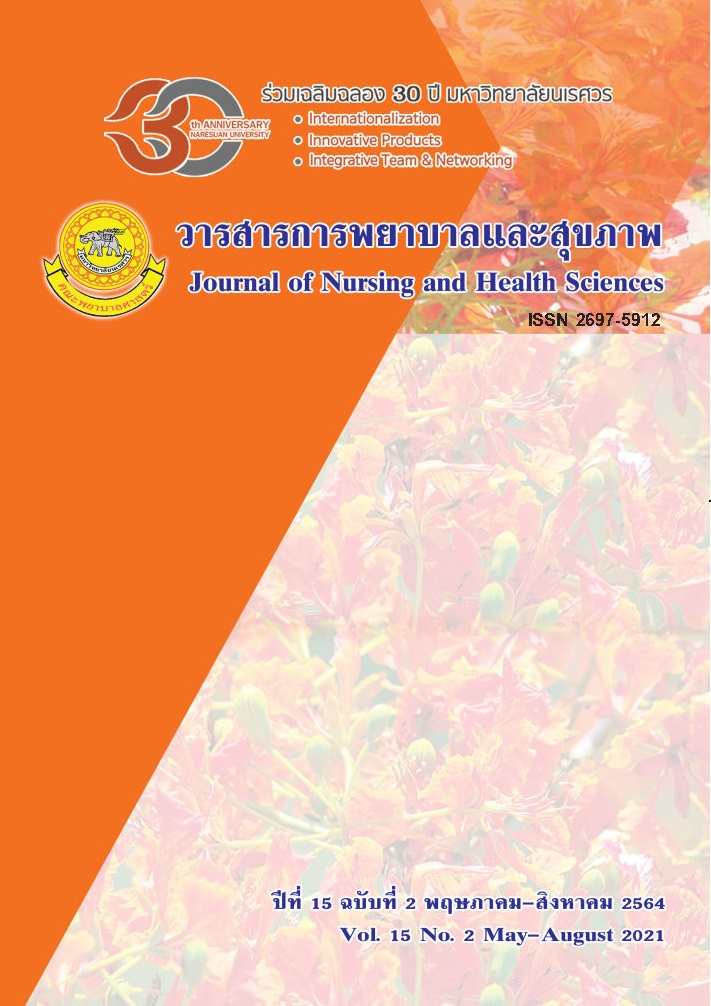The evaluation of the Bachelor of Nursing program (revised edition 2011) Faculty of Nursing, Naresuan University
Main Article Content
Abstract
This descriptive research aimed to evaluate the Bachelor of Nursing program (revised edition 2011) in terms of context, input, process, and product by using CIPP evaluation model. Participants were 243 students who graduated from the program during 2014-2018; 363 graduate employers and 38 nursing lecturers. The research instruments were 1) a questionnaire on opinions of graduates towards the program which passed the content validity checked by 3 experts (IOC value 0.50 - 1.00). Reliability tested by 30 graduates who are not the sample group, got Cronbach's Alpha coefficient of .97; 2) semi-structure interview questions regarding the nursing lecturers’ opinions toward the program, and 3) employers’ satisfaction questionnaire , standard survey of Naresuan University. Quantitative data were analyzed by mean and standard deviation, and qualitative data were analyzed by content analysis. The results showed that the Bachelor of Nursing Program according to the perceptions of the graduates as a whole was at the highest level (= 4.52, S.D. = 0.58). The three aspects were at the highest level which are product (= 4.59, S.D. = 0.56), followed by the process aspect (= 4.52, S.D. = 0.57) and the context aspect (= 4.51, S.D. = 0.57) respectively. The input aspect was at a high level (= 4.46, S.D. = 0.60). The nursing lecturers gave their opinions on the program correspondingly. The eemployees scored a high level of satisfaction with graduates' characteristics according to their learning outcomes in all aspects and every academic year. The highest aspect is morality and ethics (4.31 <<4.38; 0.54<S.D.<0.64). The lowest aspects also at high level was professional practical skills (3.78 <<4.02; 0.52<S.D.<0.78).
Article Details

This work is licensed under a Creative Commons Attribution-NonCommercial-NoDerivatives 4.0 International License.
References
Anantasawad, S., Chularee, S., and Sienun C. (2018).
Assessment of Bachelor of Nursing Program.
Suranaree University of Technology. Nakhon
Ratchasima: Suranaree University.
Faculty of nursing, Naresuan university, (2001).
Bachelor of Nursing Science Curriculum.
Phitsanulok: Naresuan university
Kuariyakul A., Chidnaee,S., Wuthurureephan,
A., Udomlert,M., Lothama,P., and Sriplakit, J.
(2017) Assessment of Bachelor of Nursing
Program Revised curriculum for the 2012
Boromarajonani College of Nursing, Uttaradit.
Journal of Boromarajonani College of Nursing
Uttaradit. 9(1): 44-58.
Kruachot, S., Noppornphan, M., Chanhom, S., Sitthipirom,
W., and Samutpradit, K. (2016). Assessment of
Bachelor of Nursing Program (revised course
of the Faculty of Nursing St. Louis College.
Journal of Health and Health Management.
(3): 10-24.
Poolchai, S., Arayathanitkul, B., Meepan, A., Intararat,
A., and Un-taeja, P.. (2019). Assessment of
Bachelor of Nursing Program. (Course updated
of the Royal Thai Army Nursing College.
Journal of the Royal Thai Army Nursing. 20(2):
-389.
Rakpuangchon,W., Wattanawilai, C., Wannapong, S.,
and Riewphaiboon, J. (2006). Assessment
results of the Bachelor of Nursing Program.
Srinakharinwirot University. Journal of Medicine
and Health Sciences.13(1) 136-145.
Stufflebeam, D.L. (2011). CIPP Evaluation model checklist : A tool for applying the CIPP Model to assess
projects and programs. PES Workshop, 5-26-12.
Sukwiboon, T.. (2009). Considerations for creating a rating scale tool for research purposes. Retrieved


